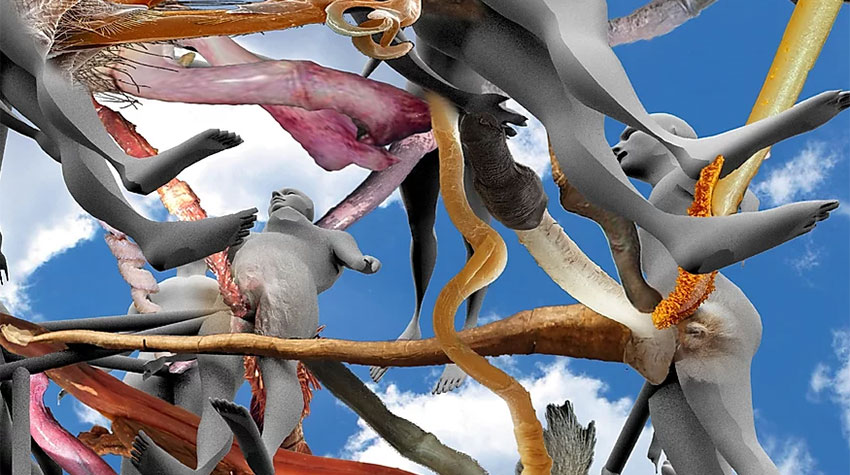Words Noam Youngrak Son

USB 3.0 Extension Cable – Male to Female Adapter Cord
High-Speed Male to Female HDMI Extension Cable
Straight Female to Female Adapter Cable Premium Stereo Gold-Plated
Multicoloured Dupont Wire 40pin Male to Female,
40pin Male to Male, 40pin Female to Female.
Excerpts from product names on Amazon
Female (of parts of machinery, fittings, etc.) manufactured hollow so that a corresponding male part can be inserted.
Male (of a fitting or part of machinery) manufactured to fit inside a corresponding female part.
English Oxford Dictionary
Gender as a concept is not only applicable to humans. When the idea of gender is applied to the cables, its meaning is reduced into a relationship of insertion. In order to critically reflect on how gender functions in this metaphor, we need to clarify what this signifies. Cables make connections through cable connectors, and the cisgender-heterosexual-intercourse happens by the insertion of genitals. Eventually, the metaphor assimilates the human bodies with the cables, and the human genitalia with the cable connectors by presuming hetero-cis-normativity. This reveals two critical standpoints: one perspective of human and cable, the other perspective of genitalia and cable connector.
Human (bodies) and cables:
Though one’s gender identity can not be determined solely by if one penetrates or is penetrated, the cable-like classifications are still the only legitimate forms of human existence in the majority of the societies. Genders of cables are the standardized ways for cables to make connections with each other, and gender binary is a mythical standard that is socially constructed, forcefully applied to individuals. Anyone who doesn’t fit neatly in that category might be comparable to the gender-non-conforming ways of connection, such as twisting the wires together. Those queer ways of cable connection are not usually recommended since it is not secure enough and may arouse confusion.
Human genitalia and cable connectors:
The progress of developmental biology, the study of the process by which animals and plants grow and develop, unveiled that Penis, Phallus, Clitoris, Phaloclitoris, Micropenis, Microphallus, Clitoromegaly are developed from the same structure during prenatal development. Phallus and Yoni are not the binary counterparts of each other, but only the ends of a wide spectrum of genitals. And there are a lot of different forms of genitalia in-between. Likewise, between “male cable connector” and “female cable connector”, there is a vast and ambiguous spectrum of androgynous-connectors. USB connectors are the most common example of this. Inside the hole of the so-called “female USB connector”, a phallic shape can be found, and that is designed to be plugged into the hole in the “male USB connector”. Despite their androgyny, they are just called male and female for the ease of communication.

Unfortunately, despite the similarity in the way that gender works in both cases, the mechanism of gender is more restrictive to us as humans than the cables. The genitalia of cables is highly plastic. Yet human genitalia that requires complex medical procedures to be modified, cable genitals can be switched/converted/split easily by connecting additional components such as a cable splitter and gender-converter. Furthermore, gendered cables always have more than one connector/genitalia since cables are designed to carry electric current between multiple ends of cables.
Though the individual connection parts can be easily classified as male or female(though you may have to ignore their ambiguity violently), it is most of the time ambiguous to tell the gender of a cable because it has more than one connection part that is male or female. Most people are not allowed to have this obscurity, as can be seen from non-consensual medical interventions on intersex infants. By using their multiple genitals, gendered cables make multiple connections at once, forming a complexed electric circuit. This, if done by humans, is also considered illegal or immoral. Unlike the cables, we are restricted in the state and plasticity of genitals that we can have by gender binarism, and also in the number of connections that we can make with it at once by monogamous norms.
Therefore, gendered cables are still deviant from the perspective of gendered people. So why not consider imitating them? By applying this metaphor of gender applied to the cables back to human, I speculate a fictional society where people’s gender is functioning like that of cables. In this sci-fi, society consists of gender-neutral post-human bodies with more than two-gendered (though it exists in a broader, non-binary spectrum) genitals each.
Their sexual intercourse happens on a big-group scale involving countless connections of genitals. Due to the multidirectional connections that they make, the intercourse is not limited on the ground surface but forms an architectural construction made of human bodies. Genetic information(perhaps contained in the body fluid as a specific type of polymer) flows along with the connections, like electricity transmitted by cables, eventually forming a network of genetic information. Offsprings can(but also may not) be made from that network, from a melting pot of genetic information of every participant.
Evolved from an asexual primitive creature that had to make its clone to reproduce, we implemented the concept of sex and began to exchange genetic information with each other, and our genetic diversity became incomparable to that of our ancestors. By speculating about the fictional ways of reproduction that references how the cables connect to each other, I am willing to discover a non-binary post-human who is as alien as us from the perspective of the asexual microbes.
Eventually, by appropriating the genders that we assigned to the cables, that are essentially nothing more than pieces of metal string wrapped in plastic, I envision this fiction to challenge our narrow understanding of human genitals, sexual intercourses, and reproduction that are limited by our body that only appears to be fixed and static.
I state the way of this investigation will be archaeological. I eventually want to communicate about the bodies and their relationships, though I will describe no more than what is written in the previous paragraphs to specify what those bodies are like. I want the post-human bodies to remain undefined, beyond the limitations of my imagination that resides in my pre-post-human body. Instead, what I’m going to illustrate is the space where their sexual intercourse(s) take place. Sara Ahmed wrote, “What makes bodies different is how they inhabit space: space is not a container for the body: it does not contain the body as if the body were ‘in it’.
Rather bodies are submerged, such that they become the space that they inhabit; in taking up space, bodies move through space and are affected by the ‘where’ of that movement. It is through this movement that the surface of spaces, as well as bodies, take shape1. I invite the readers to a fictional background without actors that I construct and let them become a detective in a crime scene or an archaeologist on site. Space that we’re living in is already fictional anyway since it was always imagined first before being realized, regardless of if it was finally built in real life or not. Let’s jump onto this stage; move on from one fiction to another.
To clarify how the speculative space that will be presented in the next part is formed in relation to reproduction, I suggest a few standpoints that you can use to decode the given space. This part is partly based on the analysis done by Paul B. Preciado in his lecture text The Architecture of Sex: Three Case Studies Beyond the Panopticon.
1.If you can see and if you can notice if you’re being surveilled are the most obvious ways for power relations(gender, race, species, etc.) to be represented in an architectural space like what can be seen from Foucault’s Panopticon.
2.How does it promote or prevent the encounter of different bodies? How does it differentiate social spaces? The pre-fab mass-produced suburban house of the 1940s and 50s illustrates this well: the consequence that it brought was ‘hypersegregation’ between middle-class white heterosexual families dwelling suburban houses and the rest that couldn’t afford that.
3.How does it facilitate or preclude the circulation of certain(organic or non-organic) reproductive fluids(blood, sperm, milk, water, capital, information, etc)? For instance, the 18th-century state brothels functioned as a collective condom that prevents the spreading of syphilis by enclosing and isolating prostitution, particularly female prostitutes from the rest of the society.
Take these frames with you and use it as a stylus of a record player that amplifies the nuances of the space that you will encounter in the next page. You open your eyes and see the satellite view of a metropolis. The city looks dense without an apparent division, though it isn’t completely homogeneous. Streets are narrow and dispersively-constructed, paved with a matt, primary-coloured surface, making a lot of intersections that are more or less alike with each other. It makes the city seem somewhat small and unorganized, even for a city of its size. What catches your eyes is a few organic-shaped glossy, and colourful structures contrasting the huge geometric buildings like pimples on dry skin.

Your point of view moves down to a balcony that is not so far from the “pimple”. The city seems like a network, the blurry network of buildings. Over the skyline, you see the tip of the structure. You can’t easily recognize it, even if you see it very apparently. The structure looks messy and organically-built, so that it sometimes looks like a living organism, though it is clearly human-made. In detail, it consists of small egg-shaped parts connected by countless tubes of various lengths. From a distance, it is not easy to tell the size of the individual sections, though you can assume the whole structure is built from a great number of those modules. Some parts of the structure are lit by a light from inside. It is a very vivid light, and you can see it from a great distance. The way it bounces off the structure’s surface makes out several distinct colours, including black.
You start walking toward that structure. When you approach the structure, you can see the egg-shaped parts more in detail. Each of those is as big as a tiny car. Those chambers look alike as if they are made for similar functions, though their details vary a lot. It doesn’t look as if it was built at once by one initiative but has been built through accumulated extensions added by the individuals. A large, translucent coating covers the surface of the structure. Some parts of it are heavily frosted so that you can’t see much detail about the inside. Several sections, especially those on top of the structure, are emitting very bright light, making it difficult to be seen clearly.
In contrast, some parts are entirely transparent so that you can see the inside. The tubes connecting the chambers are filled with viscous liquid glowing in various colours. As the liquid is flowing back and forth in the pipes, its colour and brightness subtly change. The pipes are not always straight. Some are bent in S-shape, and some draw spirals, supposedly to restrict the direction that the fluid flows.
You look into one of them. The space inside is not very spacious. It can fit nothing more than one person. Unlike how it can be seen clearly from the outside, the outside is hardly visible from the inside. There is a piece of big, organic-shaped furniture. It is made of pink synthetic leather and fur and seems composed of several layers. The softness of its surface almost gives the impression that it is alive. It is self-evident that it is for a person to recline on since a negative shape of the human back and hip is imprinted clearly on its surface. The human mark looks very ambiguous: it is difficult to distinguish if the person was male or female.
You try laying your body on the chair. A bump on the seat makes your leg spread. Compared to the other parts of the chair, the texture of the bump is closer to that of human skin, with softness, warmth, and sometimes hairs. Several hoses are attached to the bump. Each end of the hose is connected with an object that resembles the end of an electric cable. Some of the objects are phallic-shaped, some are yonic(vagina or vulva resembling) shaped, and the rest are neither phallic nor yonic, but something very unclear. By their shapes, it seems like those are designed to be connected to the genitals of the person that is on the chair.
The connectors vary a lot in size, shape, texture, and malleability: from big to small, from light to heavy, from straight to crooked to spiral-shaped, from matt to glossy to shiny, from sleek, streamlined shape to organic-shape, not only blue and pink but in various colour, sometimes soft and flexible like a sponge and sometimes rough like sandpaper. A lot of them are still wet from earlier. A strange, translucent, almost transparent fluid is slowly flowing out from some of the hoses. You assume that it came from, or at least passed by a human body considering its warmth and smell, and also from an assumption that those hoses are connected to someone else’s chair, though it is different from any other bodily fluid that you know.
You find an object on the floor. It resembles the connectors that are attached to the hoses, but it is not connected to anything. Instead of having a single phallic or yonic shape, it has one yonic form on one end and the other yonic form on the other end. You pick it up and try connecting it to one of the phallic ends of the hoses, and realize it converts the tip from phallic to yonic shape by being making a connection. You find another object on the floor, also resembling the tips of the hoses. It is Y-shaped with three different ends. Connected to one of the hoses, it splits one end into two different types of connectors.

You begin playing with the hoses, connecting one to another and to the converter and splitter you found on the floor. Some connections are made easily, almost as if it is attracted by a magnet, while some other connectors are hardly connectable with each other. And you eventually connect one connector to one of your genitals. How does it feel? Is it pleasurable? Is it empowering? Is it burdening? Does it feel like a leisure activity or like a form of labour? Then you connect another hose to another genitalia of yours again and again. Does it feel better to make more connections? Do you feel more advantaged? Do you feel more pleasure or burden by the increased number of connections?
Through one of the hoses, your vision moves to another chamber. Its basic structure is not very different from the previous one, except for a few details, including that it has a few more hoses connected to the chair and also that you can see outside. You can look through some of the chambers through their clear surfaces, yet you can’t clearly see what is in the others due to their frosted surfaces. A few rooms emit strong lights at the peak of the entire structure.
Those chambers have more connection pipes than any other chambers as if it is connected to almost every chamber in the structure. It is powerfully attracting the sight, at the same time viciously cutting off any gaze that is facing toward it. Their vague silhouettes shimmering behind the strong rays are their only visual presence. It glows enchantingly in all sorts of different bright colours, and some chambers below shines weaker by reflecting those lights.
At the bottom of the structure, there are huge metallic balls that are connected with hundreds of different chambers. Each of them has many separate doors with numbers. It is too small for a person to go through, so you assume that it is for exchanging something smaller than a grown-up person. It has keypads, supposedly meant to be opened with the passwords. The doors are firmly locked, and it is not possible to see what’s inside, but you can hear the sounds of infants crying inside very clearly. Next to it, you see an advertising board saying, Children resembling everyone, Children of democracy, are conceived here.
Then you look up again. You see the glaring chambers on top of the structure. Your gaze moves downward, along the countless pipes that connect the chambers, finally to the cry rooms at the bottom. They are all connected and supported by the pipes, hoses, connectors, genitals, bodies, presumably with the stream of fluid in them.
I conclude the observation of this (fictional) architecture by summing up the information that you obtained throughout your visual journey into a manifesto.
The world of the gendered cables is not Utopian/Dystopian/Egalitarian.
Gendered cables make the connections that may not be predefined, that may be malleable, and always in flux, that may be multidirectional.
Gendered cables make the connections not only for procreation or pleasure.
Gendered cables carry electricity/bodily fluid/genetic information/social hierarchy and structure.
Gendered cables disturb the gender-binary by ambiguating/converting/ splitting/multiplying their genitalia, which may not be binary.
Gendered cables blur the distinction between the bodies, the artefacts, and the architecture. It is ambiguous if they are natural or artificial. It consequently deconstructs the boundary of an individual: where an individual body starts and ends.
Gendered cables’ power relations are formed by the connections that they make: by how many connections it makes, and how influential those are.
Gendered cables’ power relations can be revealed through the hierarchy of their ability of perception: if it can see the other cables and if it can be seen by the other cables.






